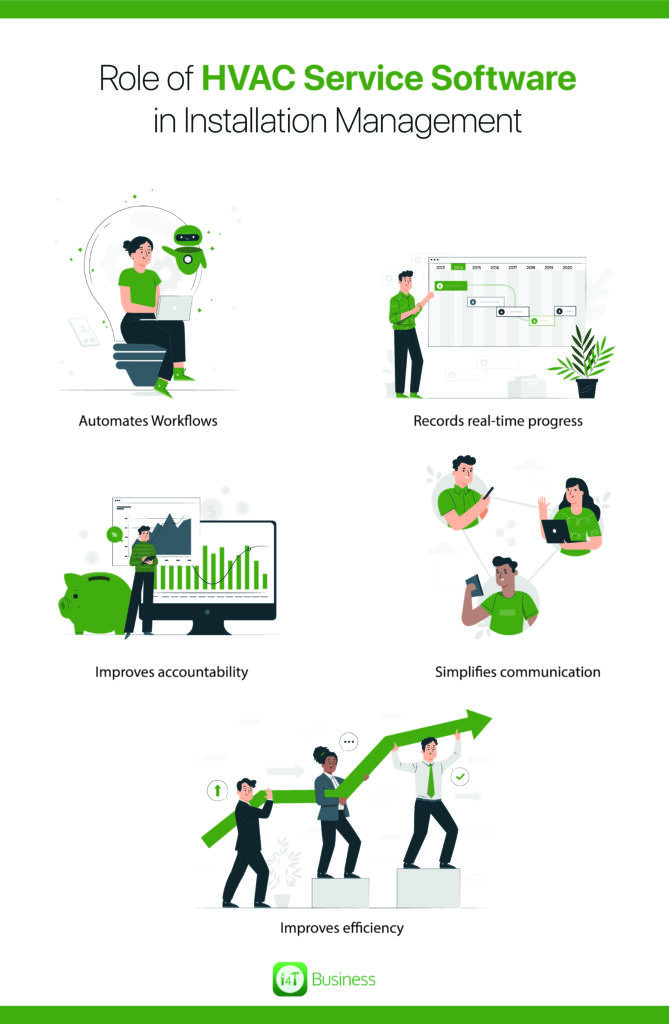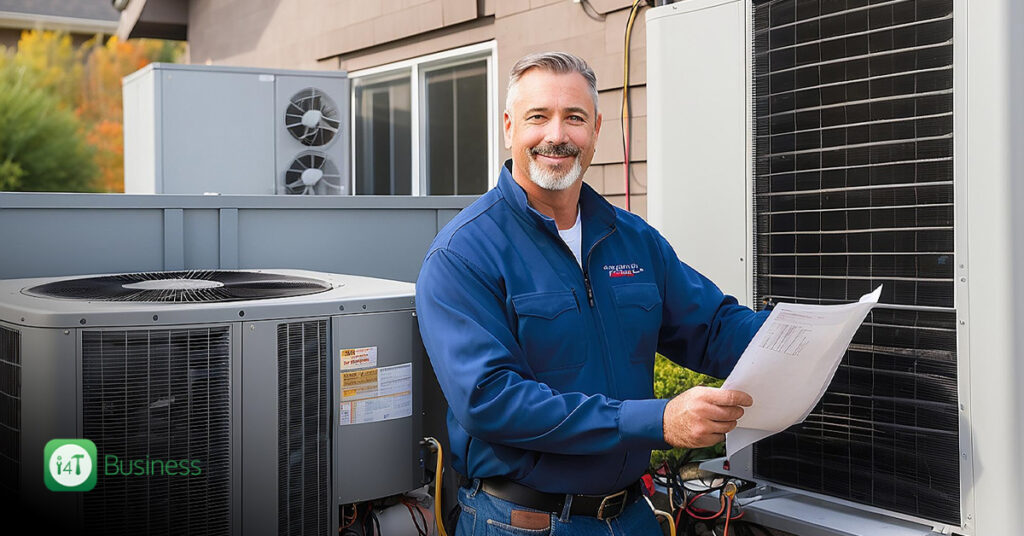Installing an HVAC system can be pretty complex, and you might have to go through several steps to complete a job. That’s where an HVAC installation checklist comes in handy. How would you feel if you had a clear checklist when installing an HVAC system?
Yes, it helps you to keep track of every step in the installation process, so that you will not miss anything. Therefore, you can complete the job the first time, saving you from costly mistakes or do-overs.
With the right HVAC service software, managing and tracking installations becomes easier.
So, are you ready to learn more about the HVAC installation checklist and how HVAC service software can help your business? Then, let’s jump right in.
Give your technicians all the steps they need to ensure a safe and compliant installation
What are the key components of an HVAC installation checklist
As you already know, there are several steps that you have to complete when installing an HVAC system. They should be included in your HVAC installation checklist so that you will not miss any important steps. Let’s look at the key components that you have to include in this checklist.
1. Pre-installation preparation
It’s crucial to prepare yourself before starting any HVAC installation. Make sure to start by taking a good look at the site conditions. Is the space ready for the installation? Check whether there’s proper ventilation, space for equipment, and access points.
Next, ensure that the system you’re installing is compatible with the building. You should check if the size, type, and power requirements match the needs of the property.
Lastly, don’t forget the permits and approvals that you would need. You might need specific approvals before moving forward depending on your area. Skipping this step can cause delays and affect your project down the road. Therefore, make sure to sort out these details in the beginning to save you a lot of headaches later!
2. Equipment installation
As you already know, it’s crucial to place both the indoor and outdoor units correctly when installing HVAC equipment. Make sure to include all facts you need to tick when fixing the units, in the checklist.
For example, when positioning the outdoor unit, you have to choose a spot with good airflow and avoid tight spaces like corners. You can also place it in the shade to prevent overheating and keep it away from windows to reduce noise.
Once that’s sorted, it’s time to handle the electrical connections. This step is crucial for the system’s safety and performance. Ensure all the wiring is connected and secured properly to avoid electrical issues down the line.
Don’t forget to double-check circuit safety and follow all necessary codes to ensure everything is up to standard. Following this step to the point will ensure that your HVAC system will run reliably and efficiently for the long term.
3. Refrigerant and ventilation setup
Setting up the refrigerant and ventilation is a key part of HVAC installation. Start by connecting the refrigerant lines carefully and make sure that each connection is secure. Once connected, it’s essential to check for leaks. A small leak might not seem like a big deal, but it can reduce the system’s efficiency and performance significantly over time.
To ensure the lines are leak-free, run a pressure test using nitrogen gas and use a leak detector or soapy water to check for any bubbling around the connections. Tighten any fittings as needed and run a vacuum test to confirm the lines hold steady.
Once the refrigerant lines are all set, the next step is ventilation. Installing the vents correctly is crucial for proper airflow, making sure the system distributes air evenly throughout the space. This helps maintain a comfortable indoor temperature and prevents the system from overworking.
4. System calibration and testing
Once you have installed the HVAC system, the next step on the list is to do system calibration and testing. First, you should make sure that the thermostat settings are adjusted properly. This is critical to ensure that the system operates at the right temperature and doesn’t overwork.
Then, check the pressure levels to confirm they’re within the recommended range for optimal performance. Don’t forget to verify the airflow and check whether it is distributed evenly throughout the space.
Finally, test the temperature control to make sure the system is heating or cooling as it should. It’s crucial to ensure that the HVAC system is running smoothly and efficiently, preventing issues down the road.
5. Post-installation cleanup
After installing the HVAC system, you need to clean up the designated area as well. This is critical to leave a good impression on your clients.
You can start the cleanup by clearing out any leftover packaging materials, wire pieces, or debris to make the area tidy. Then, make sure to do a final check to confirm that everything is in place and looks good.
After that, it’s time to educate the client about the system. Walk them through the basics of their new HVAC system. Show them how to adjust the thermostat and answer any questions they have. This helps them feel confident and prevents any confusion later on.
Role of HVAC service software in installation management

Did you know that HVAC service software can change how you handle HVAC installations? It would save you a ton of time and help to run your business smoothly.
- Automates Workflows: You can say goodbye to manual paperwork. The software automatically creates checklists for each project, making sure you don’t miss a single step and helping you manage multiple jobs more easily.
- Records real-time progress: Technicians can log their progress right from their mobile devices with HVAC software. They can check off tasks or verify steps, and it’s all tracked in real-time, keeping everyone up to speed.
- Improves accountability: The software keeps track of who did what and when, so you can make sure everything is up to standard. Therefore, you can easily catch any problems early and run your business smoothly.
- Simplifies communication: When everyone uses the same communication system, it’s easier to maintain clear communication between the field team and the office staff. Therefore, you can minimise any mix-ups or delays.
- Improves efficiency: When the software automates tasks and allows you to spend real-time updates, you can do jobs quickly with fewer mistakes. Therefore, you can reduce the stress and improve the productivity of the team.
Advantages of using HVAC service software for a checklist
Using an HVAC service software for checklist management will have several advantages for your business. As we said earlier, it makes things easier for technicians and boosts their efficiency. Here’s how the software can help you:
- Improved accuracy: Automated reminders make sure no steps are missed during installation. This helps prevent mistakes and ensures every job is done right.
- Quick job completion: The software handles the documentation part and speeds up the process. When you spend less time on paperwork, technicians can focus more on completing a job correctly.
- Maintenance records: The software saves all system data for future maintenance once you install an HVAC system. Therefore, it’s simple to track and schedule services on time.
- Easy access to data: All the information is stored in one place, so technicians can easily find details about past jobs, equipment specifications, and client needs.
- Consistent reporting: The software generates consistent reports that can be shared with clients or used internally, keeping everyone in the loop.
Wrapping up
A detailed checklist can help you to install HVAC systems smoothly, without leaving any important steps behind.
HVAC installation checklists keep everything organised and help you to avoid mistakes that could cause delays or issues down the line.
To make this process even easier, why not give HVAC service software a try?
i4T Business streamlines the entire installation process, boosts technician efficiency, and reduces the chance of errors. You can set up your workflows and checklists to ensure nothing gets missed. Technicians can tick off tasks and get approvals.
Don’t just take our word for it. Start your free trial and experience how our software can help you take HVAC installations to the next level.
FAQs
It automates checklists, tracks progress in real-time, and ensures tasks are completed efficiently without missing steps.
Yes, it optimises scheduling by assigning the right technicians to jobs, reducing downtime, and improving productivity.
It automatically logs tasks, making documentation easier and more accurate and reducing the need for manual paperwork
Yes, technicians can access and update tasks on mobile devices, logging progress in real-time from anywhere.
.
It tracks who completed each step, ensuring compliance with industry standards and improving overall quality control.
Hot off the press!

Field Service Management sector operates, the i4TGlobal Team loves to share industry insights to help streamline your business processes and generate new leads. We are driven by innovation and are passionate about delivering solutions that are transparent, compliant, efficient and safe for all stakeholders and across all touch points.










